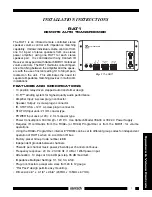
page 86
MARK-V FT-1000MP Operating Manual
O
VERVIEW
The
CAT
(Computer Aided Transceiver) System
in the MARK-V FT-1000MP provides control of fre-
quency, VFO, memory, and other settings such as dual-
channel memories and diversity reception using an
external personal computer. This allows multiple con-
trol operations to be fully automated as single mouse
clicks or keystroke operations on the computer key-
board.
The MARK-V FT-1000MP has a built-in level con-
verter, allowing direct connection from the rear-panel
CAT
jack to the serial port of your computer without
the need of any external boxes.
Each time a command instruction is being received
from the computer via the
CAT
port, the “
CAT
” indi-
cator appears in the display, then turns off afterward.
You will need a serial cable for connection to the RS-
232C (serial or COM port) connector on your computer.
Purchase a standard serial cable (not the so-called "null
modem" type), ensuring it has the correct gender and
number of pins (some serial COM port connectors use
a 9-pin rather than 25-pin configuration). If your com-
puter uses a custom connector, you may have to con-
struct the cable. In this case, refer to the technical docu-
mentation supplied with your computer for correct data
connection.
Yaesu Musen does not produce
CAT
System op-
erating software due to the wide variety of personal
computers and operating systems in use today. How-
ever, the information provided in this chapter explains
the serial data structure and opcodes used by the
CAT
system. This information, along with the short program-
ming examples, is intended to help you start writing
programs on your own. As you become more familiar
with
CAT
operation, you can customize programs later
on for your operating needs and discover the true op-
erating potential of this system.
There are some commercially produced software
packages available, as well as various shareware and
freeware programs. To find out more information, con-
tact your dealer or check advertisements in current
amateur radio journals and publications. Other valu-
able information sources include amateur radio and
PC users-groups, packet radio and PC bulletin boards
(BBS), and amateur radio hamfests.
CAT D
ATA
P
ROTOCOL
Serial data is passed via the
CAT
jack on the rear
panel of the transceiver at 4800 bits/sec. All commands
sent from the computer to the transceiver consist of
five-byte blocks, with up to 200 ms between each byte.
The last byte sent in each block is the instruction
opcode, while the first four bytes of each block are ar-
guments: either parameters for that instruction, or
dummy values (required to pad the block out to five
bytes):
Each byte sent consists of one start bit, 8 data bits,
no parity bit and two stop bits:
CAT System Computer Control
Byte 1
Argument
Byte 5
Instruction
OPCODE
Byte 2
Argument
Byte 3
Argument
Byte 4
Argument
CAT 5-BYTE COMMAND STRUCTURE
There are twenty-nine instruction opcodes for the
MARK-V FT-1000MP, listed in the table on pages 94 ~
97. Most of these duplicate menu programming set-
tings or options, or else emulate front panel button func-
tions. Notice that several instructions require no spe-
cific parameters. However, every Command Block sent
to the transceiver must always consist of five bytes.
The
CAT
control program you are writing must con-
struct the 5-byte block, by selecting the appropriate
instruction opcode, organizing the parameters, if any,
and providing unused (dummy) argument bytes for
padding the block to its required 5-byte length (the
dummy bytes can contain any value). The resulting five
bytes are then sent, opcode last, from the computer to
the MARK-V FT-1000MP CPU via the serial port and
CAT
jack on the transceiver rear panel.
Start
Bit
CAT DATA BYTE FORMAT
0
1
1
1
1
1
Stop
Bit
1
1
Stop
Bit
















































